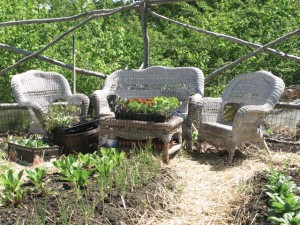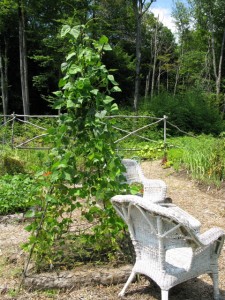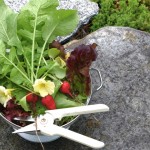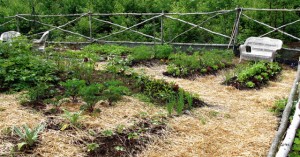The Art & Science of Designing a Vegetable Garden…
 Creating a beautiful and bountiful potager
Creating a beautiful and bountiful potager
A vegetable garden can be an incredible source of pleasure. Â Every sunny morning, my four-legged companions and I take a walk to the potager where we enjoy each other’s company while I sip my morning coffee. Â I like to start my day listening to the mocking bird and watching the butterflies flutter about the herbs and vegetables from the comfort of my old wicker chair. Although my potager is relatively small, it provides me with enough vegetables for myself, and extra to share with friends and family. Â For a modest plot, the garden is quite productive.
The renewed interest in vegetable gardening this year is exciting to observe. Jack Manix of Walker Farm presented a seminar on vegetable gardening earlier this May, and the turn-out was so overwhelming that he and his wife Karen decided to add a second session.  For those of you unable to attend the talk, this article will pass along some of Jack’s tips, as well as some of my own creative ideas and experiences for designing and planting a beautiful, productive and welcoming potager.
Bountiful harvests in the vegetable garden are usually the result of good planning. Full sun, attentiveness, regular deep-watering, disciplined weeding, and most importantly, good earth, make for success. Vegetable plants generally prefer deep, loose, well-drained soil. And the most delicious crops tend to grow in mineral rich earth with plenty of organic material worked in. Dark, fertile soil is home to aerating, fertilizing earth worms and microscopic life invisible to the naked eye. But the soil’s texture and quality is only one part of the good-dirt equation. Just as important to your plants is the soil’s fertility, provided by the nutrients in the earth. Natural, organic soil chemistry is what makes for fertile soil. Good garden soil provides balanced nitrogen, potash, and phosphorus.
Green, healthy, steady growing leaves are the result of proper nitrogen, (N). Nitrogen provides plants with nutrition, and its presence results in deep green foliage and balanced growth. Too little nitrogen and plants will be yellowish and stunted; too much nitrogen and plants will become jolly-green-giants, growing an over-abundance of lush foliage but little produce.  An excess of nitrogen can also result in poor quality fruit and plant disease. Overly fertile conditions and rapid growth also tend to attract pests like aphids. In addition to nitrogen, plants also require potash, (K), for strong, healthy growth.  Soil rich in potash will produce colorful, flavor-rich vegetables and fruit.  A lack of potash will result in poor root systems, curled and spotted leaves, and low yields. Phosphorus, (P), is another key nutrient in the garden. Like potash, phosphorus plays an important role in healthy, vigorous plant development. Cold, heat and disease resistant plants are the product of adequate phosphorus. Conversely, stunted growth and slow maturity are often signs of phosphorus deficiency.
It is important to check garden soil fertility at least once or twice a year. Â As soon as the soil dries out in spring, pick up a soil testing kit for N, P, K and pH to test your soil. Â The process is quick and easy with a kit from your local farmer’s supply store. Or if you prefer, you can send a soil sample to your local university extension service. Â Test in early spring and amend your soil according to the kit’s instructions. It also makes sense to test your garden again in fall, and amend the soil before mulching the vegetable beds for winter.
Balancing plant-diet is as important to garden health as it is to our own. Â But no matter how nutrient-rich the soil, plants need to be able to make use of what is available to them in order to grow. Checking both the soil pH, and the preferred pH of plants within the garden, will let the gardener know if the plants are able to absorb the nutrients in the soil. Correcting pH is best done in fall or early spring, but if you are building your garden at a different time, this is the first step to take no matter when you plan to begin, or what you plan to plant. Â Even the most optimally textured, fertile soil can not help plants if the nutrients can not be absorbed. Â Soil may look dark, rich and moist as chocolate cake, and it may contain a wealth of nutrients, but the improper pH will keep those nutrients out of the reach of the plant system. Incorrect pH will cause poor seed germination, and a weak, disappointing garden.
Building great garden soil is an ongoing process. Regularly adding compost to the soil helps to retain moisture, improves air circulation, and attracts earthworms and microscopic organisms. Another great addition to garden soil is green sand, which loosens clay soil, binds sandy soil, supplies potassium and helps soil hold water. Green sand is a great soil conditioner containing loads of minerals. It can be added directly to the soil, or sprinkled into compost. Â Mined from ancient ocean floors, green sand is a little-known garden secret to building great soil. Â Once I began using green sand, I was amazed at the difference in my garden.
At his vegetable gardening seminar, Jack Manix stressed the importance of waiting for proper temperatures to plant out your vegetable garden.  This is very important. Working wet soil too early can lead to compaction, and seeds planted in cold earth will fail to germinate.  If you must get a jump on the season, start plants on your windowsill or in a cold frame, and wait until the recommended planting dates for your area to sow seed. The Farmer’s Almanac is a great online source for planting dates. All you have to do is enter your zip code. Following the garden calendar and measuring soil temperature is an easy way to avoid disappointment and crop failure.
Planting the right plants for your area is also key to your success. Ask long-time residents about favorite crops, and buy your plants from a local grower. When buying seeds, Jack Manix recommends buying from companies testing in the Northeast, (or wherever you live). Some of these companies are listed under the seeds section on the links bar to the right of this post. I buy my vegetable starts from Walker Farm because they grow what they sell, so I can be certain that what I am buying has been tested and proven on the farm. I also care that my crops are raised organically, and it is important to me to support my local organic farm, and the people employed there. Why gamble money on a pretty picture in a catalog when I can see, touch and smell a plant at my local farm before I buy it ?
When planning your garden, try to make notes in your calendar as a reminder to rotate your crops each year. Â Planting vegetables in the same location makes it too easy for insects playing hide and seek in your garden. Â Make things more challenging for pests by moving crops around, and by using companion plants like calendula, (marigold), nasturtium, thyme, sage, chamomile, and other herbs and flowers. Beneficial insects are attracted to companion plants, and this helps to naturally protect your veggies from not-so-desirable creatures. Â Organic gardening starts with good planning.
Regular weeding and thinning in the vegetable garden are so important, that I make them part of my daily routine. Every morning, I spend a half hour or so gently thinning extra seedlings, and removing tiny little weeds with my hand cultivator. Removing competition from weeds and excess seedlings is essential to a plant’s success. The paths between my mounded vegetable beds are lined with straw. This makes a comfortable, dry place to sit while tending to my plants. The straw paths also retain moisture and keep down weeds. Â Weeds: the not-so-glamorous secret to successful gardening is weeding. Learning to love weeding, and making it a relaxing, meditative process, will help both you and your garden. Â In this respect the old advice, “the best fertilizer for plants is the gardener’s shadow”, couldn’t be more true. I do some of my best thinking and problem solving while weeding. Â And on my favorite days, I leave the garden thinking about nothing at all.
With this in mind, why not make your potager a truly desirable destination? Properly siting your vegetable garden is the first place to start. Almost all vegetables require full sun from dawn to dusk. This also makes the garden a pleasant place for people. An artful, winding path leading toward the potager is attractive to the eye. Make the path wide enough to easily transport plants and soil supplements via wheelbarrow. It is often true in life that the more pleasant the journey, the more frequent the trip. Adding a couple of chairs and an old table will make for a warm gardener’s welcome in a vegetable plot. Nestled amongst the fragrant herbs and flowers, a table and chairs set in the garden can be a place to read, talk on the phone, or share a glass of wine with a friend. One afternoon as I was driving home from a visit with family, I spied some cast-off wicker furniture wearing a “free’ sign, sitting on the side of the road . Now that I have found a new home for that furniture in my vegetable garden, I find that I spend much more time there. Adding annual flowers, particularly those attracting butterflies and hummingbirds, will also make a potager more inviting. My rustic fence also looks much more attractive to me with sweet peas and morning glories scrambling up the wire and winding round the saplings. A few old wicker baskets scattered about the garden are helpful for collecting weeds and spent vegetable plants for compost. And when my baskets show too much wear and tear for carrying debris, I often position them in corners to be filled with soil and trailing annuals until they decompose. This year and next, adding berry bushes and fruiting trees to the potager  are on my list. I love having a fresh pantry right outside the kitchen door, and I find the more time I spend in my garden, the happier and healthier my summer.
 Raised beds (earthen mounds) of vegetables. Â Here, last year’s radish, lettuce, bunching onions and hot peppers happily mingle.
Raised beds (earthen mounds) of vegetables. Â Here, last year’s radish, lettuce, bunching onions and hot peppers happily mingle.
 Copper-wire teepee with pole beans
Copper-wire teepee with pole beans
***
Potager and fence design : Michaela M
Fence construction : William B / Michaela M
All vegetables starts : Walker Farm or grown from seed
Article and photos â“’ 2009, Michaela at The Gardener’s Eden


3 Replies to “The Art & Science of Designing a Vegetable Garden…”
Comments are closed.